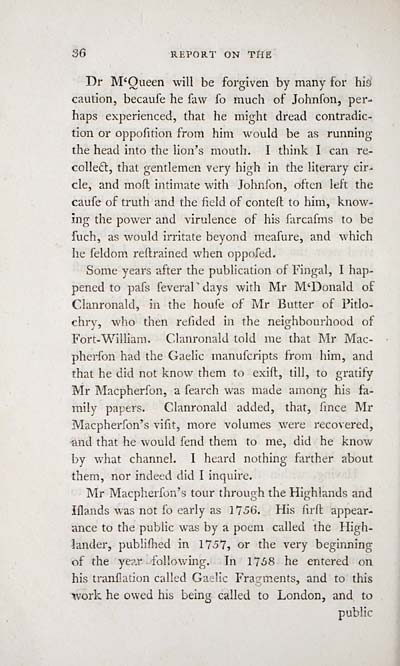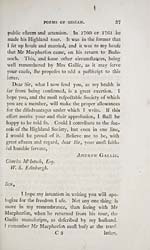Ossian Collection > Report of the Committee of the Highland Society of Scotland, appointed to inquire into the nature and authenticity of the poems of Ossian
(52)
Download files
Complete book:
Individual page:
Thumbnail gallery: Grid view | List view

36 REPORT ON TflE
Dr M'Oueen will be forgiven by many for his
caution, becaufe he faw fo much of Johnfon, per-
haps experienced, that he might dread contradic-
tion or oppofition from him would be as running
the head into the lion's mouth, I think I can re-
colled:, that gentlemen very high in the literary cir-
cle, and mod intimate with Johnfon, often left the
caufe of truth and the field of conteft to him, know-
ing the power and virulence of his farcafms to be
fuch, as would irritate beyond meafure, and which
he feldom reilrained when oppofed.
Some years after the publication of Fingal, I hap-
pened to pafs feveraPdays with Mr M'Donald of
Clanronald, in the houfe of Mr Butter of Pitlo-
chry, who then refided in the neighbourhood of
Fort-William. Clanronald told me that Mr Mac-
pherfon had the Gaelic manufcripts from him, and
that he did not know them to exift, till, to gratify
Mr Macpherfon, a fearch was made among his fa-
mily papers. Clanronald added, that, fince Mr
Macpherfon's vifit, more volumes were recovered,
and that he would fend them to me, did he know
by what channel. I heard nothing farther about
them, nor indeed did I inquire.
Mr Macpherfon's tour through the Highlands and
Iflands was not fo early as 1 756. His firfl appear-
ance to the public was by a poem called the High-
lander, publifhed in 1757, or the very beginning
of the ye-c'.r . following. In 1758 he entered on
his tranllation called Gaelic Fragments, and to this
work he owed his being called to London, and to
public
Dr M'Oueen will be forgiven by many for his
caution, becaufe he faw fo much of Johnfon, per-
haps experienced, that he might dread contradic-
tion or oppofition from him would be as running
the head into the lion's mouth, I think I can re-
colled:, that gentlemen very high in the literary cir-
cle, and mod intimate with Johnfon, often left the
caufe of truth and the field of conteft to him, know-
ing the power and virulence of his farcafms to be
fuch, as would irritate beyond meafure, and which
he feldom reilrained when oppofed.
Some years after the publication of Fingal, I hap-
pened to pafs feveraPdays with Mr M'Donald of
Clanronald, in the houfe of Mr Butter of Pitlo-
chry, who then refided in the neighbourhood of
Fort-William. Clanronald told me that Mr Mac-
pherfon had the Gaelic manufcripts from him, and
that he did not know them to exift, till, to gratify
Mr Macpherfon, a fearch was made among his fa-
mily papers. Clanronald added, that, fince Mr
Macpherfon's vifit, more volumes were recovered,
and that he would fend them to me, did he know
by what channel. I heard nothing farther about
them, nor indeed did I inquire.
Mr Macpherfon's tour through the Highlands and
Iflands was not fo early as 1 756. His firfl appear-
ance to the public was by a poem called the High-
lander, publifhed in 1757, or the very beginning
of the ye-c'.r . following. In 1758 he entered on
his tranllation called Gaelic Fragments, and to this
work he owed his being called to London, and to
public
Set display mode to: Large image | Transcription
Images and transcriptions on this page, including medium image downloads, may be used under the Creative Commons Attribution 4.0 International Licence unless otherwise stated. ![]()
| Permanent URL | https://digital.nls.uk/76520609 |
|---|
| Description | Selected books from the Ossian Collection of 327 volumes, originally assembled by J. Norman Methven of Perth. Different editions and translations of James MacPherson's epic poem 'Ossian', some with a map of the 'Kingdom of Connor'. Also secondary material relating to Ossianic poetry and the Ossian controversy. |
|---|
| Description | Selected items from five 'Special and Named Printed Collections'. Includes books in Gaelic and other Celtic languages, works about the Gaels, their languages, literature, culture and history. |
|---|

